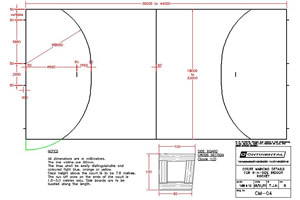Hockey (indoor)
 Indoor hockey requires a suitable skirting down the sides of the court to ensure the ball stays in play. This skirting should be angled downwards to prevent the ball kicking upwards off the surface. This can be achieved either by permanent specialist skirting down the sides of the walls (if it is accepted not to have the recommended run-off down the sides of the court), or by the use of portable removable hockey sideboards – Continental can supply either of those solutions.
Indoor hockey requires a suitable skirting down the sides of the court to ensure the ball stays in play. This skirting should be angled downwards to prevent the ball kicking upwards off the surface. This can be achieved either by permanent specialist skirting down the sides of the walls (if it is accepted not to have the recommended run-off down the sides of the court), or by the use of portable removable hockey sideboards – Continental can supply either of those solutions.
A hockey court (even at minimum size) is too large to fit in a standard 4-court hall, however our experience is that school hockey can be successfully played in such a hall using a smaller court.
We have included some useful drawings for download at the foot of this page:
- Drawing CM-04 – shows the standard markings for an indoor hockey court
Layout and run-off guidance for in indoor hockey pitch: |
Community | Club | Premier | International |
| Minimum height over court (mm) |
No prescribed minium height applies | |||
| Length (mm) (min-preferred) |
36000-44000 | 36000-44000 | 36000-44000 | 36000-44000 |
| Width (mm) (min-preferred) (excluding sideboards) |
18000-22000 | 18000-22000 | 18000-22000 | 18000-22000 |
| Run-off behind back lines (mm) |
3000 | 3000 | 3000 | 3000 |
| Clearance outside sideboards (mm) | 1000 | 1000 | 1000 | 1000 |
| Extra one side for officials and team areas- min (mm) | N/A | 1200 | 1200 | 1200 |
| Notes | ||||
| The playing area should be kept to a ratio of 2:1 length:width | ||||

